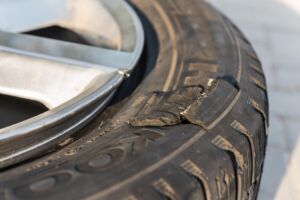Getting stuck with a flat tire on Charlotte’s busy highways is more than just an inconvenience. It’s a safety hazard that can cost you time, money, and peace of mind. The good news? Most tire failures don’t happen without warning.
Learning to recognize the early signs your tire is about to go flat can save you from dangerous roadside emergencies. Whether you’re commuting on I-485 or navigating Charlotte’s pothole-filled streets, knowing these warning signs helps you address problems before they leave you stranded. At Sunny Day Towing & Auto Transportation, we see preventable tire emergencies daily that could have been avoided with early detection. Our team at (704) 504-7449 responds to tire emergencies throughout Charlotte and surrounding areas, but we’d rather help you avoid the emergency altogether.
Here are five critical warning signs that indicate your tire is heading toward failure.
Table of Contents
ToggleUneven or Rapid Tread Wear
Healthy tires wear evenly across the entire tread surface. When you notice bald spots, excessive wear on one side, or tread disappearing faster than normal, your tire is compromising its structural integrity.
What causes uneven wear patterns? Poor wheel alignment, incorrect tire pressure, or suspension problems force certain areas of your tire to work harder than others. Charlotte’s rough roads, with their frequent potholes and construction zones, accelerate this uneven wear significantly. You can check tread wear using the penny test.
Why this leads to flats: Thin or uneven tread creates weak spots that puncture easily. A nail that might bounce off a healthy tire can penetrate worn tread and cause sudden air loss. The compromised structure also makes the tire more susceptible to blowouts at highway speeds.
Visible Cracks or Bulges in the Sidewall
Sidewall damage is one of the most serious warning signs your tire is about to go flat. Look for small cracks running along the sidewall, bubble-like bulges, or cuts in the rubber surface.
Common causes include: Age-related deterioration, UV damage from North Carolina’s intense summer sun, impact from hitting potholes or curbs, and manufacturing defects that worsen over time.
Bulges are particularly dangerous because they indicate internal structural damage. The tire’s steel belts have separated or broken, creating a weak spot that can fail without warning. Even small bulges require immediate tire replacement.
The danger level: Unlike slow leaks, sidewall failures typically result in sudden blowouts rather than gradual air loss. This makes them especially hazardous during highway driving when you need maximum tire integrity for safe handling and braking.
Never attempt to repair sidewall damage. Unlike tread punctures, sidewall problems cannot be safely patched or plugged.
Frequent Need to Add Air
All tires lose air naturally over time, but healthy tires should maintain proper pressure for several weeks or months. If you find yourself adding air weekly or noticing significant pressure drops between monthly checks, your tire has developed a leak.
What causes air loss: Small punctures from nails or screws, damaged valve stems, microscopic porosity in aging rubber, or poor sealing between the tire and rim. Temperature changes common in Charlotte can mask slow leaks, as pressure naturally drops in cooler weather and rises when temperatures climb.
A tire that loses 1-2 PSI per month is normal. Losing 5-10 PSI weekly indicates a problem that will worsen progressively. Small leaks rarely seal themselves and typically expand as debris works deeper into the puncture or as tire flex widens the hole.
The progression to failure: Slow leaks force you to drive on underinflated tires, which generates excessive heat and weakens the tire structure. This combination often leads to sudden catastrophic failure, especially during long drives or hot weather when heat buildup peaks.
Vibrations or Unusual Noise While Driving
Your tires should roll smoothly and quietly under normal driving conditions. Vibrations felt through the steering wheel, seat, or floorboard often indicate internal tire damage that’s not visible from the outside.
Types of concerning vibrations: Rhythmic thumping that increases with speed suggests a separated tread belt or flat spot. Side-to-side vibrations typically indicate sidewall problems or wheel damage. Vibrations that worsen during turns point to specific tire damage.
Sounds that signal trouble: Irregular thumping, humming that changes with speed, or road noise that seems louder than normal from one side of the vehicle. These sounds often indicate internal damage to the tire’s steel belts or separation between rubber layers.
Not all vibrations come from tire problems. Wheel balance issues, alignment problems, or suspension wear can create similar symptoms. However, vibrations combined with other warning signs strongly suggest impending tire failure.
Age-Related Deterioration
Even tires with excellent tread can fail if they’re too old. Rubber compounds deteriorate over time regardless of mileage, making older tires prone to sudden failure.
How to check tire age: Look for a four-digit code on the sidewall starting with “DOT.” The last four digits indicate the week and year of manufacture. For example, “3018” means the 30th week of 2018.
Most tire manufacturers recommend replacement after six years, with ten years being the absolute maximum regardless of appearance. Charlotte’s heat and humidity accelerate rubber deterioration, making this timeline even more critical for local drivers.
Why old tires fail suddenly: Age causes internal bonds to weaken and rubber to become brittle. The tire may look perfectly fine externally while harboring invisible structural damage. When these aged components finally fail, they do so catastrophically rather than gradually.
What to Do When You Spot These Warning Signs
If you notice any of these signs your tire is about to go flat, take immediate action. Reduce your driving speed and avoid highway travel when possible. Schedule a professional tire inspection promptly to determine whether repair or replacement is necessary.
Some warning signs, like sidewall bulges or severe uneven wear, require immediate tire replacement. Others, like minor slow leaks, might be repairable if addressed quickly. When in doubt, err on the side of caution.
For emergency situations where tire failure occurs despite prevention efforts, professional mobile tire services can provide roadside assistance safely and efficiently.
Conclusion
Recognizing these five warning signs your tire is about to go flat helps you avoid dangerous roadside emergencies and costly repairs. Regular tire inspection takes just a few minutes but can prevent hours of delay and hundreds of dollars in additional damage.
Stay proactive about tire maintenance and address warning signs promptly. When tire emergencies do occur, Sunny Day Towing & Auto Transportation provides reliable mobile tire repair and towing services throughout Charlotte and surrounding areas. Contact us at (704) 504-7449 for professional assistance when you need it most.
Remember, preventing tire emergencies is always safer and more cost-effective than dealing with roadside breakdowns on Charlotte’s busy streets.



